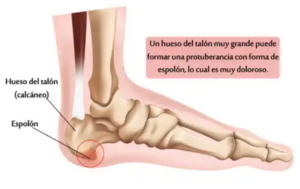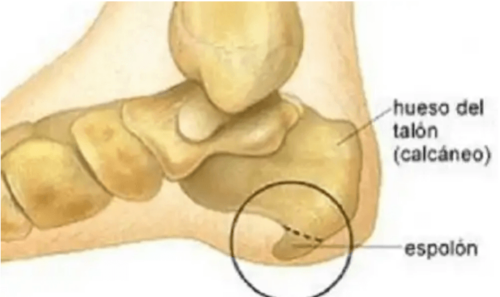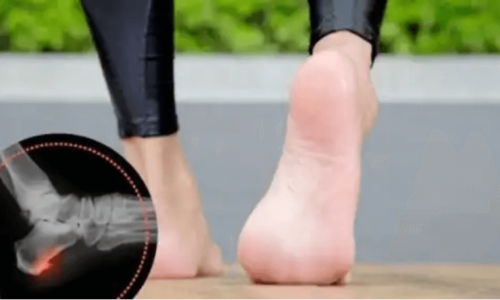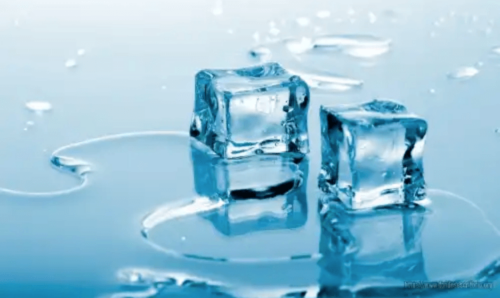Can You Cure a Heel Spur Naturally?

A heel spur is a protrusion that appears as a result of traction and overload. In short, it’s a growth of the heel bone that modifies the gait and causes acute pain (like pins and needles).
On an X-ray, you can see it as a triangular or spear-shaped bump. Some of the most common causes are gait disorders (very marked and uncorrected) in feet with high arches and supination, obesity, excess weight, the use of inappropriate footwear, rheumatic diseases, and playing sports on hard surfaces, among other things.
This injury is also known as “Haglund’s deformity“. It occurs when the junction point of the skin’s bones with the tendons becomes inflamed. Afterwards, it appears in the form of a pointed protrusion and can cause a lot of pain, especially when the person overexerts themselves or stands up for many hours at a time.
Symptoms and causes of a heel spur

A heel spur is usually accompanied by a series of symptoms that usually appear in the morning, after waking up. At this time, the pain is the most intense.
The symptoms are very easy to detect because, in addition to the protrusion, there’s oppressive pain when you touch the Achilles’ heel area or when you exert the tendon.
There’s another type of heel spur, plantar fasciitis or policeman’s heel, which is diagnosed through an X-ray and causes a bump oriented towards the toes. So, the main causes of heel spurs are:
- Intense exercise
- Having arched or flat feet
- Slouching
- Excess weight or obesity
- The use of inappropriate footwear
- Bad posture while walking
- Spending too much time on your feet
Discover: Five Benefits of Not Wearing High Heels
Exercises you can do to relieve pain from a heel spur
Although exercise may seem counterproductive, the truth is that you must make your heel stronger and, at the same time, relaxed enough to avoid more severe pain.
Stretches are very important and you should do them not just when symptoms appear, but as a preventive measure. Below, we’ll give you some exercises that make recovery easier.
Exercise 1
Sitting in a chair or on a bed, stretch out your foot in line with your leg. Your toes should point down as far as possible. Then, point your toes up to the ceiling. Repeat each of these 10 times.
Another useful exercise is to raise your leg, take your toes and pull them towards you. The idea of this is to stretch the sole as much as possible in order to reduce tension and pain.
Exercise 2

Some people use small balls (e.g. a tennis ball) to do exercises and treat the heel spur. Barefoot, rest the ball under the sole of your foot. Then, exert some pressure as you make circular or lateral movements.
Exercise 3
This exercise is very simple and all you need is a towel to do it. You’ll have to lay the towel down on the floor and, with bare feet, take it with your fingers and pull it towards you. You can place a weight on the towel if you want to increase the energy, so that it offers some resistance to your movement.
Exercise 4
Sitting exercises are of great benefit for people with very busy days, as you can perform them during any moment of free time. For this, you’ll need to be barefoot. Then, place the sore foot on the contralateral calf and move it slowly up and down. For better results, constantly do them every day.
Exercise 5
Relaxing your calves can also help relieve pain caused by heel spurs. Fortunately, there’s an exercise for this purpose. To do it, just lean on a table, placing one foot in front of the other. Then, bend the front knee and stretch the back knee by supporting the heel. The idea is to maintain this position to stretch the muscles of the leg behind you.
Other pain relief measures
In the evenings, many patients with this problem use an element known as night splint. This leaves the foot extended and better rests the fascia plantar. However, the use of it should be monitored by a specialist to avoid possible complications.
During the day, you can use a special orthopedic insoles that reduce pain and correct bone calcification. These insoles have a soft spot on the heel to cushion your steps. They’re custom made so you should consult a doctor beforehand.
In the case you do sports, it’s really important to do some warm-up activity, as it will prevent injury or stop it getting worse. It’s also very important to wear suitable footwear for the activity that you’re doing (this also applies to people who don’t exercise).
Professionals also recommend reducing physical activity that can generate high pressure on your heel. Ideally, you want to reduce the use of the affected area in order to get rid of the heel spur. It’s necessary to distribute your body weight adequately between your 2 feet and to rest as much as possible during the nights if physical activity is unavoidable.
You should also read: The Best Exercises to Stretch Your Muscles
Can you cure a heel spur naturally at home?
Putting ice on, doing certain exercises, using the mentioned insoles, and replacing footwear with one that allows you to walk comfortably, are some of the basic measures to get relief.

Regarding whether there are natural remedies for heel spurs, yes, there are supposedly several, but they don’t work. In other words, applying vinegar compresses won’t make the bump disappear nor will applying a marigold cream stop the pain.
It’s important for the patient to follow their doctor’s instructions and avoid resorting to natural remedies, since they usually don’t work. However, ice cubes are an exception as they can actually provide some relief.
If you have this problem and want some relief, put several ice cubes in a plastic bag, cover it with a thin gauze, and then place it on the affected area. You can also put your foot in a container with cold water and ice cubes.
All cited sources were thoroughly reviewed by our team to ensure their quality, reliability, currency, and validity. The bibliography of this article was considered reliable and of academic or scientific accuracy.
- Ortiz Repáraz, A. (2012). Talalgia: Espolón calcáneo y fascitis plantar. DOLOR.
- Sarmiento Sánchez, E., Suárez Monzón, A., Delgado Figueredo, R., & Cabrera Suárez, J. (2007). Tratamiento quirúrgico del espolón calcáneo. Medisur: Revista Electrónica de Las Ciencias Médicas En Cienfuegos.
- Orellana Molina, A., Hernández Díaz, A., Larrea Cox, P. J., Fernández Yanes, S., & González Méndez, B. M. (2010). Láser infrarrojo frente a acupuntura en el tratamiento del espolón calcáneo TT – Infrared laser vs. acupuncture in the treatment of heel spurs. Revista de La Sociedad Española Del Dolor.
This text is provided for informational purposes only and does not replace consultation with a professional. If in doubt, consult your specialist.








